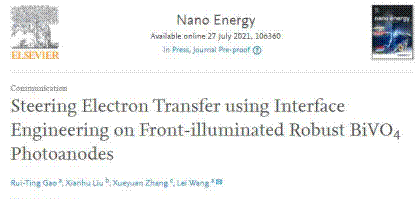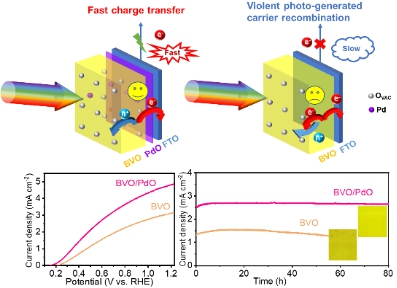Recently, the research team led by Wang Lei of the School of Chemistry and Chemical Engineering of IMU made progress in the photogenerated electron transfer of BiVO4. The team published in Nano Energy, a top journal in the field of energy of the world whose effect factor is 17.881, an academic article about the improvement of PEC performance of the front-illuminated BiVO4 by applying the PdO layer. And the article is entitled “Steering Electron Transfer Using Interface Engineering on Front-illuminated Robust BiVO4 Photoanodes” (url: https://doi.org/10.1016/j.nanoen.2021.106360). IMU is the institution that the leading author and correspondent author are with. Gao Ruiting, a PhD candidate who enrolled in IMU in 2020, is the leading author of the article and Prof. Wang Lei the correspondent author.

In the photoelectrochemical water splitting, BiVO4 is prone to the influence of the recombination of the surface, interface and intrinsic carrier of BiVO4, which seriously constrains the electron-hole transfer of BiVO4. Through applying the decoration of cocatalyst and surface passivation to the surface recombination of BiVO4, the electron separation and transfer in BiVO4 is effectively accelerated. With doping cation and anion, the electrical conductivity of BiVO4 is increased, which, in turn, restrains the carrier recombination. The way to prevent the negative shift of electron between BiVO4 /substrate in BiVO4 and improve the combination between BiVO4 /substrate and electron’s transferability is another key problem in the study of PEC. BiVO4 is one of the important materials in solar-driven photoelectrochemical water splitting for producing hydrogen and has attracted wide attention in recent years. In the long-term testing of photostability, it is highly likely that cathodic photocorrosion happens to the electrode of BiVO4 at the BiVO4/substrate junction. There are few research reports about the way to constrain the photocorrosion. Recently, Prof. Wang Lei-led research team has added, for the first time in the world, Pd layer at the BiVO4/substrate junction and effectively improved the transfer performance of the electron of BiVO4. Pd layer plays 2 roles in the reaction: 1. With Pd , PdO layer is formed in the heat treatment, which accelerates the electron transfer; 2. In the process of material production, a trace amount of Pd is doped into BiOI, and more defects and vacancies are induced in BiVO4, which strengthens the electrical conductivity and is conducive for the fast electron transfer. The formation of PdO layer effectively constrains the cathode photocorrosion at the BiVO4/substrate junction and improves the performance of front illumination of photocathode. And photoanode of BiVO4/PdO attains the similar photocurrent density of front/back illumination. With further front illumination, BiVO4 exhibits over 80-hour photostability, which is the longest front-illuminated photostability as has been reported. The research opens a new avenue to design an unbiased photovoltaic device with tandem structure.

The research was financially supported by the National Natural Science Foundations of China (Grant No. 51802320, 21965024), the Inner Mongolia Fund for Distinguished Young Scholars (Grant No. 2020JQ01), Start-up Fund of Inner Mongolia University for Newly-Joined Talents(Grant No. 21300-5195102) and other funds.
A Brief Introduction to Correspondent Author: Wang Lei, professor and PhD supervisor with the School of Chemistry and Chemical Engineering of IMU. Since December, 2018, she has independently conducted her research work and made herself included in the “Grassland Elite Talents” Project of Inner Mongolia and “Distinguished Young Scholars” Program of Inner Mongolia. As the leading author or correspondent author, she has published 49 articles in Angew. Chem. Int. Ed.(4 articles), Adv. Mater.、Adv. Funct. Mater.、Nano Energy(3 articles), ACS Catal. (2 articles) and Mater. Horiz.. Since its establishment in January, 2019, her research team has published 14 articles in the first section of chemistry and engineering of Science Citation Index journals.
Research team’s homepage: https://www.x-mol.com/groups/imu_wanglei

